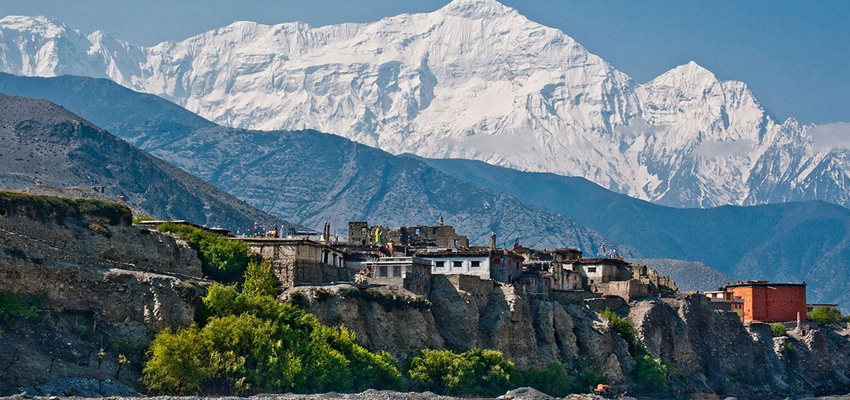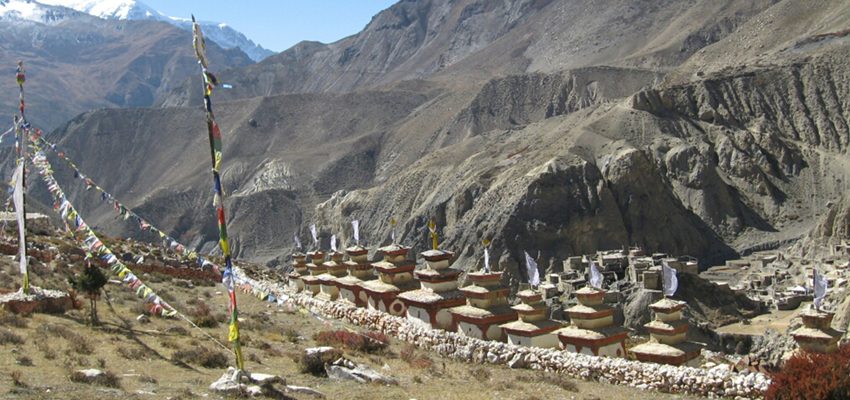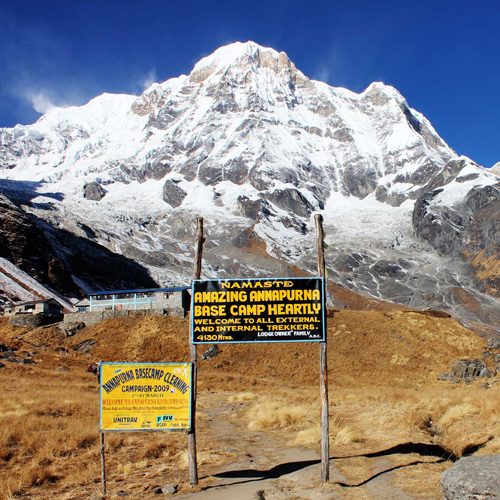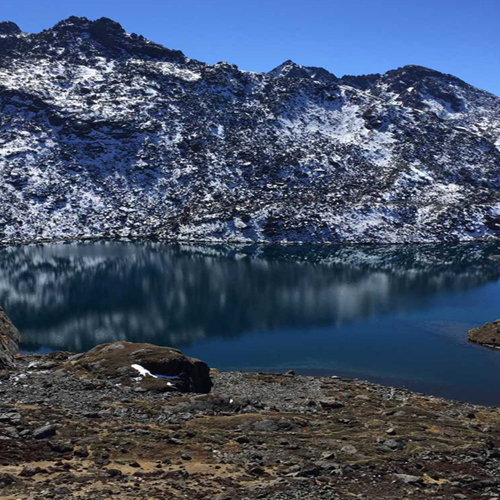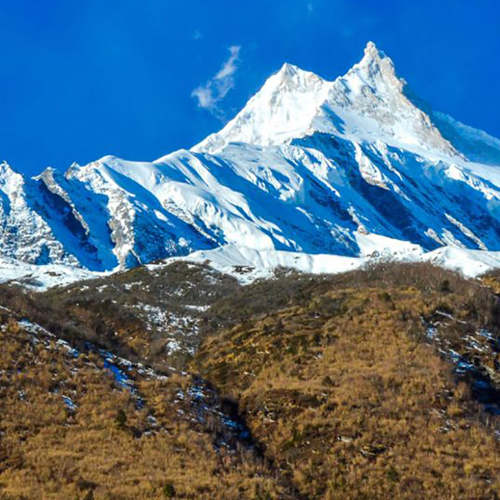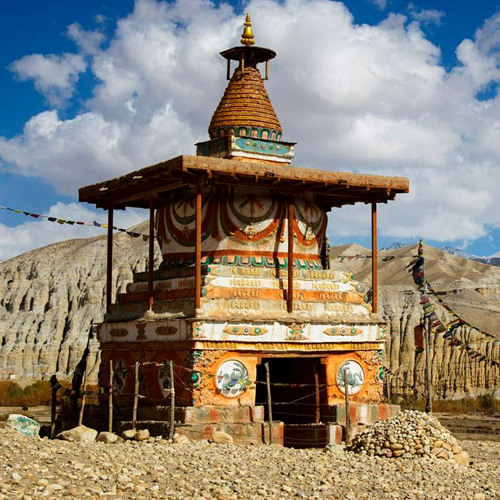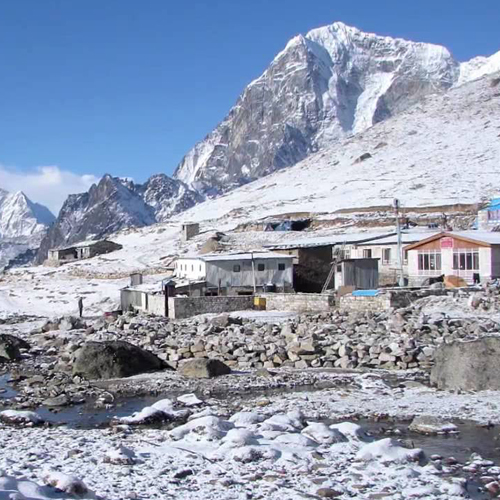Day 1: Drive to Koto
Leave Kathmandu early and drive first to Besisahar. After lunch, change to a four-wheel drive vehicle for the rugged journey to Koto. The road can be almost as challenging for passengers as for drivers, but it is incredibly scenic! It travels along the old Annapurna Circuit trek route, through amazing gorges and past stunning waterfalls. Arrive in Koto in time for dinner.
Day 2: Trek to Meta
Leaving the village of Meta behind, start the day early, as there is a lot of distance to cover. Cross the river and enter the Nar & Phu valleys. Towns on the nearby Annapurna Circuit are relatively well developed, but this is not the case in these valleys.
Today’s trekking route passes through beautiful woods, past small cave shelters and pilgrims’ resting places. Emerging from a narrow canyon, the trail passes under a wide waterfall, from which point the woods become thinner and the vistas wider. The last stretch into Meta involves climbing a steep hill, from which there are amazing views of some of the giant snowy peaks in the area.
Meta lies on a big open plain and consists of a few lodges, which are simple but clean and offer good meals.
Day 3: Trek to Phu
Trekking out of Meta, some of the unique, colorful Tibetan Buddhist chortens that Nar and Phu are famous for begin to appear in sight. The trail meanders along the ridge with a good view of the magnificent Nar Phedi monastery, where you will stay in a few days’ time. After another ninety minutes hiking through scenic canyons and gorges, you’ll reach a monolith that guards the steep trail up to Phu.
From here, you can get your first view of the three villages in the area as well as the old “dzong” (Tibetan-style fortress) and the remains of two ruined forts, impressively situated atop the flatlands before the village. Just before crossing the bridge into Phu, a line of wonderful chortens color the landscape.
After a rest and refreshments, take a short walk up to the famous Tashi Lhakhang Gompa to pay respects to Lama Karma Sonam Rimpoche who came to Nepal with the Dalai Lama in 1959.
Day 4: Exploring Phu
Due to the high altitude, it’s good to spend an acclimatization day in Phu. Explore the tiny alleyways of the town or hike up to Himlung Himal base camp. Phu itself is an interesting village, and a day is well spent sitting with the villagers as they spin their yak and sheep wool, pound mustard seeds into a paste for oil, or go about their other daily chores.
For an extra challenge, the hike up to Himlung Himal base camp takes you through a glacial valley. The 7,125 m. peak was recently opened for climbing. On the trail up you will see herds of blue sheep skillfully clambering up the steep cliffs. The return trip takes about four to five hours.
Day 5: Trek to Nar Phedi (3,490m)
Trekkers on the way to Nar Retrace the route back down towards Meta, but turn off at the Nar Phedi monastery, which will be your accommodation for the night. In fact, the monastery is all that Nar Phedi consists of.
The rooms are neat and clean and the nuns are extremely welcoming. Join them in the kitchen and watch them prepare dinner on a modest fireplace. At 5 pm they usually do a puja (blessing), which you are welcome to witness. There is a small donation box in the monastery where you can leave a contribution for the maintenance of this beautiful and friendly place.
Day 6: Trek to Nar Village
Today is a very gentle day. Climb out of Nar Phedi and follow a winding path up a hill towards Nar. Pass a line of wonderfully painted, bamboo-topped chortens on the way into the ancient village. Arrive in the town around lunch time. Even though Nar is not far from the main Annapurna trail, it is rarely visited by trekkers and is about as picturesque as it gets.
Nar is bit more social and lively than Phu, and during the day you may find the village ‘square’ teeming with chatting women with their back-strap looms weaving wool fabric for rugs and blankets. With a few new teahouses built on the outskirts of Nar, you can stay in a comfortable lodge with an extensive menu.
Day 7: Trek to Ngawal via the Kang La Pass (5,240m)
Today is a long day, so get up before sunrise and head towards the Kang La pass, which leads back onto the popular Annapurna Circuit. It is not a difficult pass, but it can be a long day as the effects of altitude will be felt. Once on top of the pass, you can enjoy an amazing view over Annapurna II, Gangapurna, and Tilicho Peak. The trail down starts off steep, but if you enjoy scree running you can have some fun! Stop for lunch on a plateau overlooking the peak, then continue towards Ngawal.
Ngawal, on the upper Pisang route of the Annapurna Circuit, is certainly very different from the ancient villages just visited. The lodges are big, the menus much more comprehensive and there will be Wifi and phone signals in most lodges.
Day 8: Trek to Pisang and drive to Besisahar
The weather gets much hotter and the scenery greener as you descend more than 2000m from the pass. Set off early for the last few hours of trekking to reach Pisang. The trail is wide and comfortable and passes a beautiful lake just outside Pisang. Stop for a quick snack in the village, then take a four-wheel drive back to Besisahar. There, stay in a comfortable hotel.
Day 9: Drive back to Kathmandu
The drive back to Kathmandu takes around five hours.Enjoy a hot shower and the luxuries of the city once again! Spend the afternoon shopping for souvenirs in Thamel, or just relaxing.

